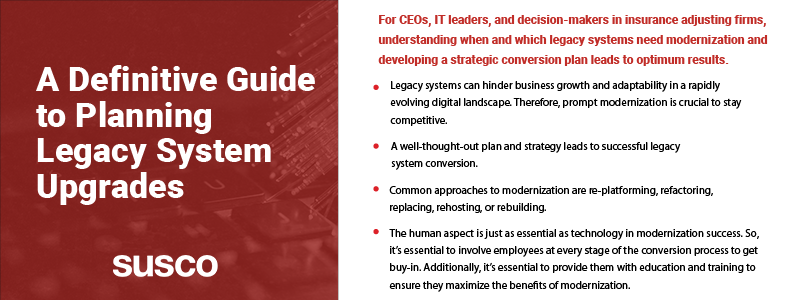For CEOs, IT leaders, and decision-makers in insurance adjusting firms, understanding when and which legacy systems need modernization and developing a strategic conversion plan leads to optimum results.

Three words that terrify CEOs, IT leaders, and decision-makers in insurance-adjusting firms alike are legacy system modernization.
Too often, legacy conversion refers to a long, arduous effort to redesign outdated systems accumulated over decades into something approximating 21st-century user experience (UX) and performance. The result is almost always unsatisfactory. In addition to the effort, money, and time expended, there’s also the opportunity cost of forgoing other initiatives. And the outcome is rarely as user-friendly, functional, flexible, or agile as imagined.
Luckily, it doesn’t have to be that way. By being strategic about modernization, you can minimize the cost and effort of your digital transformation initiative while ensuring the results are optimal from a UX, performance, and functionality standpoint. That means you no longer have to hang onto outdated technologies and processes that hinder business growth and adaptability.
This article draws valuable insights from years of experience in legacy system conversions to help business leaders and IT professionals navigate the transformation process efficiently and effectively. Keep reading.
Evaluating the need for legacy conversion
With technology constantly evolving, many businesses have more legacy systems than they can upgrade all at once. So, it’s essential to carefully assess how different legacy systems affect employee experience, customer experience, and operations when prioritizing modernization.
Prioritize systems for modernization that:
- Hinder performance, including all slow and inefficient systems that crash often, hamper productivity, and don’t integrate well with other technologies you use.
- Present the most significant security risks, including those not receiving security updates or with known vulnerabilities you cannot address.
- Don’t align with the organization’s long-term needs, objectives, and goals.
- Cost more to maintain than the value they deliver.
- Are at a high risk of failure —particularly if integral to your business. Examples include systems that rely on obsolete programming languages that few people know about.
These factors signal that your software doesn’t serve your organization as well as it should, meaning it’s time for a legacy system conversion.
Planning and strategy for legacy conversion
Many challenges in legacy conversion can hinder successful implementation. So, it’s essential to create a well-thought-out plan and strategy.
Start by defining your modernization goals and objectives in as much detail as possible. Specify the outcomes you want to achieve, such as better employee experience, scalability, improved security, lower costs, or increased productivity. However, ensure they’re realistic to avoid frustration.
Additionally, consider the total cost of implementation, including employee training, software licenses, infrastructure improvements, and unforeseen contingencies, and allocate funds accordingly. Keep in mind that the speed and scope of the conversion impact cost, so also factor them in the budgetary considerations. Remember to allocate enough time for the modernization initiative for a smooth transition.
Technological approaches to modernization
There are various legacy system modernization strategies depending on the results you want to achieve, budget constraints, and the current state of existing systems. Most organizations typically take one of five approaches: re-platforming, refactoring, replacing, rehosting, or rebuilding. Each has its pros and cons, as detailed below.
- Re-platforming moves legacy systems to a new environment (typically an IaaS or a colocation facility) while making some code adaptations. Replatforming is a great short-term alternative to running an on-premises data center. However, the long-term costs and technical debt of maintaining legacy systems in the cloud can quickly add up.
- Refactoring entails optimizing code to remove technical debt without changing its core functionality. It enhances efficiency and reduces maintenance costs but fails to address the challenges of systems that use outdated and outmoded architectures.
- Replacing involves scrapping the entire system and replacing it with a new one. It provides a fresh start when the existing system is outdated, though it can disrupt business operations when not planned well.
- Rehosting takes advantage of cloud computing as-is or with minimum modifications. It lets you quickly migrate to the cloud with minimum disruptions but doesn’t maximize the benefits of full-blown modernization.
- Rebuilding: This entails fully modernizing the legacy system’s design and architecture. It leverages DevOps methodologies and technologies like declarative APIs, immutable infrastructure, microservices, service meshes, and containerization to reduce long-term operation costs, improve performance, and enhance flexibility. Rebuilding lets you reap the full benefits of modernization, but it takes longer, and the initial costs are higher than those of alternatives.
Managing the human aspect of conversion
As conversions typically entail significant changes to workflows, systems, and processes, employees may resist these transformative initiatives due to concerns about disruptions during the transition, a lack of expertise with new technologies, or fear of job loss.
The following legacy system modernization strategies can help you navigate the human element:
- Involve employees early to foster a sense of ownership.
- Communicate the reasons behind the conversion clearly and transparently and its benefits for employees and the organization.
- Solicit employee feedback to learn about their concerns, expectations, and suggestions regarding the conversion.
- Offer comprehensive training to equip employees with the necessary skills to use the new technology.
Embracing a future-proof IT landscape
Before embarking on a legacy conversion initiative, it’s essential to evaluate the current state of your existing tech stack and validate which systems need modernization and in what order. Setting realistic goals, timelines, and budgetary allocations is also crucial for success.
Based on your business needs, re-platforming, refactoring, replacing, rehosting, or rebuilding may be ideal. For example, while rehosting can help you quickly move to the cloud, a full rebuild is necessary to maximize the benefits of modernization.
Modernizing legacy systems is the best way to position your organization for future growth and innovation. So, it’s essential to promptly make the switch to stay competitive.
Susco can be your partner in planning legacy system upgrades. Get in touch to learn more.